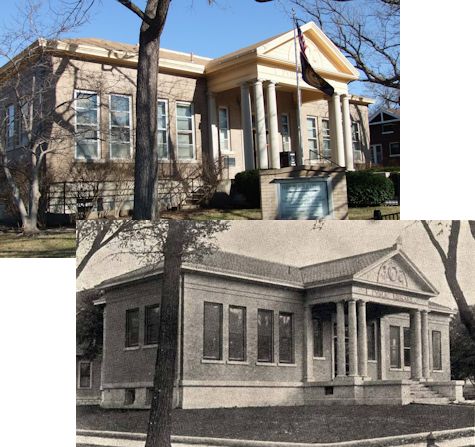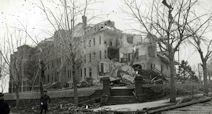Search the Blog
Categories
- Books & Reading
- Broadband Buzz
- Census
- Education & Training
- General
- Grants
- Information Resources
- Library Management
- Nebraska Center for the Book
- Nebraska Memories
- Now hiring @ your library
- Preservation
- Pretty Sweet Tech
- Programming
- Public Library Boards of Trustees
- Public Relations
- Talking Book & Braille Service (TBBS)
- Technology
- Uncategorized
- What's Up Doc / Govdocs
- Youth Services
Archives
Subscribe
Category Archives: Information Resources
National FY 2011 Library Data Now Available
The Institute of Museum and Library Services (IMLS) announced today that the latest update of the Public Libraries Survey (FY 2010-2011) is now available on the IMLS Website. The research tool, Compare Public Libraries, has also been updated with this latest data. The official Public Libraries Survey report for 2011 will be published in the early fall of 2013.
Posted in Information Resources
Leave a comment
Meet the Library Commission Reference and Interlibrary Loan Staff!
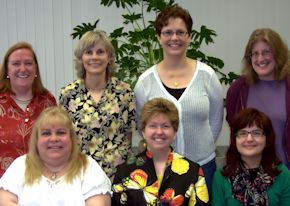
Front row left to right: Mary Geibel, Mary Sauers, and Lynda Clause
Back row – left to right: Lisa Kelly, Beth Goble, Bonnie Henzel and Susan Knisely
Meet the Library Commission Reference and Interlibrary Loan Staff!
In the past year and half, we’ve experienced several changes in personnel on our reference and interlibrary loan team. Here are the updates as to the whereabouts of our former staff in addition to our new arrivals:
Departures:
January 2012:
Julie Pinnell – leaves the Library Commission after nearly 17 years of service to become the director of the Doane College Library.
Summer 2012:
Beth Goble – becomes part time and is now our Historical Services Librarian. She still spends time at the reference desk answering email questions and will celebrate 20 years with the state this July. Beth and her husband Ron travel regularly to Michigan to visit their two granddaughters and also spend time at their other home in Alberta, Canada. Not to be left out are the family pets, Arwen, a Sheltie and Allie, a rescue cat.
December 2012:
Dave Eckmann leaves the reference team to return to working with the Talking Book and Braille Service.
April 2013:
Evelyn Kubert retires after 13 years of doing ILL for the Library Commission and just received happy news of grandchild number 6.
Arrivals:
January 2013:
Mary Sauers comes to us by way of Lincoln City Libraries where she worked at the Anderson and Bethany Branches in public services. Prior to moving to Nebraska in 2009 she worked at BCR, the former OCLC regional network located in Denver. It was there that she met her husband, Michael Sauers, who you may recognize as another employee of the Library Commission. Mary has two daughters (Diana and Sara), three dogs, and spends many hours in her greenhouse.
Mary Geibel is already recognizable to many of you since she’s been answering and routing incoming calls to the Nebraska Library Commission for many years as a member of the Administrative Services team. Since the reference desk recently took over “switchboard” duties it’s a particularly fitting time for Mary to transition to our team, where she will be one of several team members answering the phones. Mary will also now be your first contact for book group reservations and questions. Mary and her husband John have two sons (Sean and Nikolas) and two dogs. Mary cares for her mother in her home and also enjoys regular meetings with her scrapbook friends.
April 2013:
Lynda Clause is our most recent team member and also comes to us by way of Lincoln City Libraries. Lynda will be working primarily with Interlibrary Loan and helping and guiding us in our change to WorldShare. Lynda will also be at the reference desk and will be corresponding with you all by email. Lynda is planning to return to school this fall to study Digital Humanities, but she will still be here at NLC full time. Lynda and her partner Eric enjoy hiking and live music, and are planning to adopt a dog from the Humane Society this summer and we are all eager to see who will join their home.
Still here:
Bonnie Henzel continues helping the team on Friday mornings. Bonnie works with Nebraska State Publications and is the proud mom of a son Alex and twin high school graduates (Alaina and Kayla) who will matriculate at Peru State College this fall. Bonnie is married to Vince and together they are active in coaching basketball and volleyball. Last but not least in their home is Bonnie’s Golden Retriever Chloe.
Susan Knisely is a part of the Technology and Access Services Team but also spend time at the reference desk on Mondays. Susan is the person you speak to for overdrive and database subscription questions in addition to many other topics. Susan and her husband Will share their home with their son Ian and 4 rabbits.
Lisa Kelly remains at the reference desk after 20 years and has learned many new tasks as people have come and gone. Lisa lives with her rescue cat named Moon in the historical Stuart Building where she organized a book group that has been meeting for 12 years. Susan and Lisa are a month apart in age and have planned their joint retirement party for the year 2035.
Posted in General, Information Resources
Tagged Nebraska Library Commission Staff, NLC Staff, Staff
4 Comments
Busting sod
This week marks the 151st anniversary of the passage of the Homestead Act on May 20, 1862. Homesteaders were allotted 160 acres of land. They had to live on their land and make improvements within six months, including building a home. After 5 years on the land, the original filer was entitled to the property after paying a small registration fee. On January 1, 1863, Daniel Freeman met some local Land Office officials and convinced a clerk to open the office shortly after midnight in order to file a land claim. Freeman became one of the first to file a claim. 160 acres proved to be too small for the arid parts of Nebraska. The Kinkaid Act of 1904, authored by Nebraska Congressman Moses P. Kinkaid, increased the allotment to 640 acres in western and central portions of Nebraska, primarily in the Sandhills.
Trees were in short supply , and the tough sod
being “busted” for crop production became 
building blocks for homes, barns, and even schools.
Several Nebraska Memories participants have
contributed photos depicting homesteaders.
The house in this photo of the Mundshaw’s Sod House from the Cheyenne County Historical Society collection looks quite substantial, with a durable roof and glass windows. It probably had a wood floor as well. 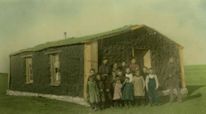 Cheyenne county also boasted a Sod School in District #68 . It actually had a stone foundation. Eight of the children in this 1904-05 picture are named Olsen, with photographer Otto Olsen using a string to snap the photo so that he could be in it.
Cheyenne county also boasted a Sod School in District #68 . It actually had a stone foundation. Eight of the children in this 1904-05 picture are named Olsen, with photographer Otto Olsen using a string to snap the photo so that he could be in it.
Other parts of Nebraska had trees for lumber. 
Mr. and Mrs. James Cornell and their children
stand in front of a wood frame house in Butler County
in this photograph from the Boston Studio Project
collection, taken in the late 1890s.
 There was no Kingsley Dam or Tri-County irrigation canal holding and diverting water from the Platte River into parched fields in Phelps County in those early days. It’s hard to imagine how the family in the 1880’s photo of their Dry land farm, Phelps County, Nebraska survived. The rows of corn look dried up. Perhaps the windmill behind the house provided enough water for the crop.
There was no Kingsley Dam or Tri-County irrigation canal holding and diverting water from the Platte River into parched fields in Phelps County in those early days. It’s hard to imagine how the family in the 1880’s photo of their Dry land farm, Phelps County, Nebraska survived. The rows of corn look dried up. Perhaps the windmill behind the house provided enough water for the crop.
Visit Nebraska Memories to search for or browse through many more historical images digitized from photographs, negatives, postcards, maps, lantern slides, books and other materials.
Nebraska Memories is a cooperative project to digitize Nebraska-related historical and cultural heritage materials and make them available to researchers of all ages via the Internet. Nebraska Memories is brought to you by the Nebraska Library Commission. If your institution is interested in participating in Nebraska Memories, see http://nlc.nebraska.gov/nebraskamemories/participation.aspx for more information, or contact Beth Goble, Historical Services Librarian, or Devra Dragos, Technology & Access Services Director.
Posted in General, Information Resources, Nebraska Memories
Leave a comment
2012 Nebraska Public Libraries Survey Data Available
The results of the 2011/2012 Public Libraries Survey for Nebraska are now available for downloading on the Library Commission website. The full statistics are provided in Excel format or as a comma-delimited file. There is also a summary document of total figures that can be downloaded either in Excel or Adobe Acrobat format.
Celebrate National Nurses Week
National Nurses Week is celebrated every year from May 6, which is National Nurses Day, to May 12, which is the birthday of Florence Nightingale. After taking a moment to thank the nurses that you know, explore these images of nurses in Nebraska Memories.
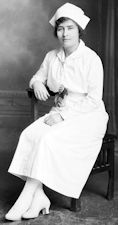 For a look at nursing uniforms of the past, check out these portraits of Emily Anderson, taken in 1920, and this unknown nurse, taken in the late 1890s or early 1900s. Their outfits are a far cry from the scrubs and comfortable shoes worn by nurses today.
For a look at nursing uniforms of the past, check out these portraits of Emily Anderson, taken in 1920, and this unknown nurse, taken in the late 1890s or early 1900s. Their outfits are a far cry from the scrubs and comfortable shoes worn by nurses today.
Many of the images of nurses in Nebraska Memories are part of the  Alegent Health Immanuel Medical Center collection. They depict many different aspects of life for students at the Immanuel Deaconess Institute School of Nursing. Images in this collection include a posed shot of a group of freshman students, a team photo of the School of Nursing’s women’s basketball team and a view of a capping ceremony, in which students
Alegent Health Immanuel Medical Center collection. They depict many different aspects of life for students at the Immanuel Deaconess Institute School of Nursing. Images in this collection include a posed shot of a group of freshman students, a team photo of the School of Nursing’s women’s basketball team and a view of a capping ceremony, in which students 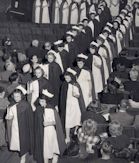 received their nursing caps after their first year probation.
received their nursing caps after their first year probation.
Visit Nebraska Memories to search for or browse through many more historical images digitized from photographs, negatives, postcards, maps, lantern slides, books and other materials.
Nebraska Memories is a cooperative project to digitize Nebraska-related historical and cultural heritage materials and make them available to researchers of all ages via the Internet. Nebraska Memories is brought to you by the Nebraska Library Commission. If your institution is interested in participating in Nebraska Memories, see http://nlc.nebraska.gov/nebraskamemories/participation.aspx for more information, or contact Beth Goble, Historical Services Librarian, or Devra Dragos, Technology & Access Services Director.
Posted in General, Information Resources, Nebraska Memories
Leave a comment
WorldCat Reaches 2 Billion
WorldCat, the OCLC database of library holdings, has received its 2 billionth entry. The bouncing baby record was added by the University of Alberta in Edmonton last Saturday.
“Saturday’s child works hard for a living” according to the old poem, and WorldCat’s records work hard to provide information about the contents of libraries world wide. Nebraska libraries can search WorldCat through FirstSearch in NebraskAccess.
Posted in Information Resources
Leave a comment
Three Carnegie Libraries
As National Library Week comes to an end I wanted to highlight a few of the sixty plus Carnegie libraries that were built across Nebraska. When talking about Carnegie libraries I’m referring to those libraries built with the help of Andrew Carnegie. According to information on the Library of Congress’s website Carnegie helped to build over 2,500 libraries worldwide. You may also recognize his name in connection with the Carnegie Hall and Carnegie Mellon University.

- Chadron Public Library
The first building I want to highlight is the Chadron Public Library. The bulding is located at 507 Bordeaux St in Chadron as is still the current home of the Chadron Public Library. The building was designed by George Berlinghof of Lincoln who received $100 for the architectural plans. The building was completed in 1911. Comparing the photo of the library in Nebraska Memories taken sometime in the 1920’s to a more recent photo taken in 2006 you can see the front of the building is relatively unchanged. The most noticeable change is the removal of the decorative windows. According to the National Register of Historic Places Registration Form these windows were removed in 1964 as part of effort to make the building more energy efficient.
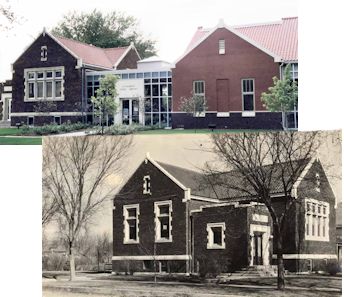
- Gothenburg Public Library
Let’s head a bit southeast and look at the Gothenburg Public Library. The library is located at 1104 Lake Ave in Gothenburg. This Carnegie library was completed in 1916. Comparing the recent photo and the historical photo you can see that an addition was added that mimics the lines of the original building.
For our last stop let’s look at the Fairbury Public Library. The library is located at the corner of 7th and F Street. Carnegie donated $12,500 for the library which was built on a lot purchased by the city for $2,500. The building was designed by Tyler and Son of Lincoln. It opened to the public in December of 1909 and is still being used today.
As I was researching the Fairbury Carnegie building I found an article in the 1908 North Platte semi-weekly tribune that mentioned that the town of Fairbury was asking Mr. Carnegie for additional funds. The article also stated: “They Library will be practically a duplicate of the one at Kearney.”
Comparing the historical images of the Fairbury Public Library and the Kearney Public Library I was surprised to see how similar they looked on the outside. Unfortunately we can’t compare current photos of the Carnegie buildings because the building in Kearney was torn down in 1975. We can however see what the Adult Reading Room and the Children’s Room looked like in the Kearney Carnegie building in the 1920’s.
Visit Nebraska Memories to search for or browse through many more historical images digitized from photographs, negatives, postcards, maps, lantern slides, books and other materials.
Nebraska Memories is a cooperative project to digitize Nebraska-related historical and cultural heritage materials and make them available to researchers of all ages via the Internet. Nebraska Memories is brought to you by the Nebraska Library Commission. If your institution is interested in participating in Nebraska Memories, see http://nlc.nebraska.gov/nebraskamemories/participation.aspx for more information, or contact Beth Goble, Historical Projects Librarian, or Devra Dragos, Technology & Access Services Director.
Posted in General, Information Resources, Nebraska Memories
Leave a comment
Libraries: Narrowing the Digital Divide
Last year, the Bill & Melinda Gates Foundation released two videos on YouTube, “Libraries: More Than Books” and “Libraries: Changing Lives, Transforming Communities”. They were the first in a series of videos that the Gates Foundation was creating to show how digital services in libraries are transforming lives.
Now all of the videos are available on the Gates Foundation’s YouTube channel in a playlist called Libraries: Narrowing the Digital Divide.
The videos cover a range of topics: job searching, empowering seniors, serving immigrants, searching for health information. Library staff and patrons tell the stories of how the technology available at the library has helped them.
You can use these videos to promote these same services at your library or to advocate for adding new services. Maybe they will inspire you to make your own videos, with your patrons and staff sharing how your library has improved their lives. Take a look!
100 years ago this month: The Omaha Easter Tornado of 1913
They called it the Devil Cloud. At about 6:00 pm on March 23, 1913 the “Easter Sunday Tornado” struck Omaha and cut a swath from 49th & Poppleton Sts. through Carter Lake to Council Bluffs Iowa. 140 citizens were killed and 400 injured. News of Omaha’s disaster went out on the only surviving telegraph wire — the Omaha Daily News. It remains one of Omaha’s greatest distasters, killing at least 150 people and injuring many more. This account from the March 25th 1913 EXTRA editon of the Omaha Daily Bee shows a map of the storm’s path.
The Idlewild Club at 2307 North 24th Street was the scene 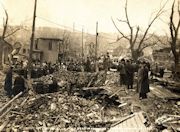 of the greatest loss of life. The owner, C. W. Dillard, and 13 customers were killed as they tried to take shelter on the south side of the pool hall’s basement. The victims were crushed by falling debris or overcome by smoke from fires begun when woodstoves used for heating overturned. The postcard image shows the slow process of removing the debris to recover the bodies. The victims were then removed to the Webster Telephone Exchange Building at 2213 Lake Street.
of the greatest loss of life. The owner, C. W. Dillard, and 13 customers were killed as they tried to take shelter on the south side of the pool hall’s basement. The victims were crushed by falling debris or overcome by smoke from fires begun when woodstoves used for heating overturned. The postcard image shows the slow process of removing the debris to recover the bodies. The victims were then removed to the Webster Telephone Exchange Building at 2213 Lake Street.
 This image of a house wrecked and burned at 26th & Patrick Avenue in northeast Omaha illustrates the danger. Fire was breaking out along the corridor of destruction. Entire police and fire departments from Omaha and Council Bluffs, Iowa, were called to the scene. They fought the fires along Franklin and Decatur streets 3 blocks south of Patrick Avenue for nearly an hour. Firemen carried hoses because trucks could not reach the flames. Heavy rain fell after 8 p.m. and by 9 p.m. the houses were smoldering ruins. The piano sitting out front may be the only thing that was saved.
This image of a house wrecked and burned at 26th & Patrick Avenue in northeast Omaha illustrates the danger. Fire was breaking out along the corridor of destruction. Entire police and fire departments from Omaha and Council Bluffs, Iowa, were called to the scene. They fought the fires along Franklin and Decatur streets 3 blocks south of Patrick Avenue for nearly an hour. Firemen carried hoses because trucks could not reach the flames. Heavy rain fell after 8 p.m. and by 9 p.m. the houses were smoldering ruins. The piano sitting out front may be the only thing that was saved.
The Sacred Heart Convent immediately to the south of Bemis Park suffered heavy damage. The color postcard of the Academy of the Sacred Heart shows what it looked like before the storm. The photograph on the right of the Sacred Heart Academy shows the damage to the side facing Bemis Park.
Many more tornado images documenting the destruction the tornado caused are in the Omaha Public Library collection in Nebraska Memories . The 100th anniversary of the Easter Tornado will be featured in an NET television progam called Devil Clouds: Tornadoes Strike Nebraska to be broadcast March 22nd.
Visit Nebraska Memories to search for or browse through many more historical images digitized from photographs, negatives, postcards, maps, lantern slides, books and other materials.
Nebraska Memories is a cooperative project to digitize Nebraska-related historical and cultural heritage materials and make them available to researchers of all ages via the Internet. Nebraska Memories is brought to you by the Nebraska Library Commission. If your institution is interested in participating in Nebraska Memories, see http://nlc.nebraska.gov/nebraskamemories/participation.aspx for more information, or contact Beth Goble, Historical Services Librarian, or Devra Dragos, Technology & Access Services Director.
Posted in General, Information Resources, Nebraska Memories
1 Comment
Talking Books: Here, Now.
Here is a short (2 minutes 20 seconds) video about talking book service to schools and, of course, to students who qualify for free talking book service.
We hope to target Nebraska school media specialists, special ed resource teachers, and students who experience a print-related disability. Hope you enjoy it. Feel free to pass it on!
Census Changes Highlighted in Demo
The U.S. Census Bureau will hold a demonstration of new data access tools live online via the Census Bureau Ustream channel on Thursday, January 31 at 1:00 p.m. (CST). The demo will include new and enhanced features in American FactFinder, such as Community Facts and Guided Search as well as provide a look at other new data access tools, including Easy Stats, developed from the Census Bureau’s Application Programming Interface, and the America’s Economy mobile app. Viewers will be able to ask questions, either by phone or asking via the Census Bureau’s Facebook and Twitter accounts.
Posted in Census, General, Information Resources, What's Up Doc / Govdocs
Tagged census
Leave a comment
E-book Reading Jumps; Print Book Reading Declines
Lee Rainie and Maeve Duggan, of the Pew Research Center’s Internet & American Life Project, authored a new study, E-book Reading Jumps; Print Book Reading Declines showing that the population of e-book readers is growing. In the past year, the number of those who read e-books increased from 16% of all Americans ages 16 and older to 23%. At the same time, the number of those who read printed books in the previous 12 months fell from 72% of the population ages 16 and older to 67%.
Overall, the number of book readers in late 2012 was 75% of the population ages 16 and older, a small and statistically insignificant decline from 78% in late 2011. The move toward e-book reading coincides with an increase in ownership of electronic book reading devices. In all, the number of owners of either a tablet computer or e-book reading device such as a Kindle or Nook grew from 18% in late 2011 to 33% in late 2012. As of November 2012, some 25% of Americans ages 16 and older own tablet computers such as iPads or Kindle Fires, up from 10% who owned tablets in late 2011. And in late 2012 19% of Americans ages 16 and older own e-book reading devices such as Kindles and Nooks, compared with 10% who owned such devices at the same time last year.
This move toward e-books has also affected libraries. The share of recent library users who have borrowed an e-book from a library has increased from 3% last year to 5% this year.
Beyond that, there is growing public awareness that the vast majority of public libraries now lend e-books. In the entire population of those ages 16 and older, the number who are aware that libraries offer e-book loans increased from 24% last year to 31% now. At the same time, there has been a drop in the number of people who do not know whether their local library has an e-book borrowing program.
Have you seen a similar increase paired with a similar decline in your local community? Comment below to share your library’s experience.
NCompass Live: ACCESSNebraska: the Department of Health and Human Services Website – Recorded Online Session
 We all have people come into our libraries looking for help applying for food stamps, foster care, Medicaid, etc. Stacy Schenk, Community Support Specialist at the Nebraska Department of Health and Human Services, will give us a tutorial on how we can best serve our patrons using their ACCESSNebraska website and resources.
We all have people come into our libraries looking for help applying for food stamps, foster care, Medicaid, etc. Stacy Schenk, Community Support Specialist at the Nebraska Department of Health and Human Services, will give us a tutorial on how we can best serve our patrons using their ACCESSNebraska website and resources.
Download audio (MP3)
Subscribe via RSS
Subscribe via iTunes
Video (YouTube)
Presentation Slides (SlideShare)
Links (Delicious)
For more information, go to the NCompass Live webpage.
Census Bureau Releases New Web Tool
The U.S. Census Bureau launched a new web application today called, “Easy Stats,” a tool designed to make statistics easier to access. It provides selected demographic and economic statistics from the American Community Survey (ACS) and allows searching by geography down to the local level. You can road test the new app at http://www.census.gov/easystats/. The Census Bureau has also updated the popular QuickFacts site with the new ACS statistics, making it easier to find data about a city, county, or state.
Posted in Census, General, Information Resources, Technology, What's Up Doc / Govdocs
Tagged census
Leave a comment
“And when the votes are counted you will never know they ran”
“And when the votes are counted you will never know they ran”. At least that’s what James Asher Parks wrote back in 1908 in the campaign song “Holding Hands”. Here’s the complete second verse:
“Willie Hearst* and Billy Bryan* tried to play a little game, “Holding hands,” Parker too, and poor old Davis likewise tried to do the same, “Holding hands,” The candidates they’re running all are “three-spots” to a man, And when the votes are counted you will never know they ran, You will find them all a standing just about where they began, “Holding hands!””
 I think Mr. Parks might be correct. I knew who Willie Hearst and Billy Bryan were but I must admit I had no idea who Parker and Davis might be. After a quick search I believe he is referring to Alton B. Parker and Henry G. Davis. Alton Parker ran for president in 1904 and Henry G. Davis was his vice-president candidate. As you may know Parker lost that election to Theodore Roosevelt.
I think Mr. Parks might be correct. I knew who Willie Hearst and Billy Bryan were but I must admit I had no idea who Parker and Davis might be. After a quick search I believe he is referring to Alton B. Parker and Henry G. Davis. Alton Parker ran for president in 1904 and Henry G. Davis was his vice-president candidate. As you may know Parker lost that election to Theodore Roosevelt.
“Holding Hands” is just one of twenty-four songs that appear in “Park’s Republican campaign songs”. This book of scores was written by James Asher Parks who was a famous composer and publisher from York Nebraska. “Holding Hands” can be found on page 25. Many of the other scores in this book made me laugh and others made my cringe. I never realized how nasty politics were in 1904.
As you were reading the lyrics above you may have noticed the asterisks after Hearst’s and Bryan’s names. Asterisks like these appear throughout this book. The footnote that goes along with these asterisk states: “Use name of any Democrat desired.” Mr. Parks included an announcement at the front of the book letting folks know that because of the “early demand for Campaign music” these songs were written before the presidential candidates were officially announced. He went on to say that any candidates name could be substituted and “As a rule, any name of two syllables will serve the purpose.” He also stated that folks should “Commit the words and music to memory before rendering and sing with VIM and VIGOR.”
 The song “Holding Hands” was clearly a song for the opponents of William Bryan to sing. To be fair I also wanted to point out two scores that support William Bryan. The first one is “Bryan’s Democratic success march” written by George Maywood (also known as George Schleiffarth). Unfortunately there’s not much to say about this score since it has no lyrics. The other song written in support of Bryan is called “Line up for Bryan”. It was written by Nebraska Lawyer and politician George W. Gale. This song does include lyrics.
The song “Holding Hands” was clearly a song for the opponents of William Bryan to sing. To be fair I also wanted to point out two scores that support William Bryan. The first one is “Bryan’s Democratic success march” written by George Maywood (also known as George Schleiffarth). Unfortunately there’s not much to say about this score since it has no lyrics. The other song written in support of Bryan is called “Line up for Bryan”. It was written by Nebraska Lawyer and politician George W. Gale. This song does include lyrics.
“We are marching on to victory There’s music in the air, We’ll place our gallant leader in the presidential chair We are ready for the battle now we’re waiting for the day We’ll fall in line for Bryan boys Hip Hip Hooray.”
I hope you enjoyed this break from modern day politics and were amused by politics of the past. Do you think after the votes are counted and a hundred or so years pass that folks will remember who ran and lost today’s election?
Visit Nebraska Memories to search for or browse through many more historical images digitized from photographs, negatives, postcards, maps, lantern slides, books and other materials.
Nebraska Memories is a cooperative project to digitize Nebraska-related historical and cultural heritage materials and make them available to researchers of all ages via the Internet. Nebraska Memories is brought to you by the Nebraska Library Commission. If your institution is interested in participating in Nebraska Memories, see http://nlc.nebraska.gov/nebraskamemories/participation.aspx for more information, or contact Beth Goble, Historical Projects Librarian, or Devra Dragos, Technology & Access Services Director.
What to do if Your Identity is Stolen
Having your identity stolen is a terrible experience. The Federal Trade Commission, in partnership with the Public Library Association, has produced a suite of materials on identity theft and identity protection and made them available for download or bulk ordering from the FTC website http://ftc.gov/idtheft. A booklet featuring step-by-step instructions on dealing with the crime can also be borrowed from the Library Commission. Brochures on the website offer tips for recognising child identity theft. Three animated videos are also available.
Everything on the site can be downloaded and is in the public domain to be shared with patrons. Bulk orders of free copies can also be ordered at https://bulkorder.ftc.gov. The FTC would like to hear how libraries are using these resources. Email them at outreach@ftc.gov.
NCompass Live: Health Information for Your Community – Recorded Online Session
 CHIRS, the Consumer Health Information Resource Service, and the National Library of Medicine databases are free resources available to all Nebraska residents. Teri Hartman from the McGoogan Library of Medicine at the Univ. of Nebraska Medical Center, and Marty Magee, the Nebraska Coordinator for the National Network/Libraries of Medicine, will show you how to use these services to provide reliable health information to your community.
CHIRS, the Consumer Health Information Resource Service, and the National Library of Medicine databases are free resources available to all Nebraska residents. Teri Hartman from the McGoogan Library of Medicine at the Univ. of Nebraska Medical Center, and Marty Magee, the Nebraska Coordinator for the National Network/Libraries of Medicine, will show you how to use these services to provide reliable health information to your community.
Download audio (MP3)
Subscribe via RSS
Subscribe via iTunes
Video (YouTube)
Presentation Slides (Slide Share)
Links (Delicious)
For more information, go to the NCompass Live webpage.
Posted in Information Resources
Leave a comment
NCompass Live: Your Government Online: The White House, the Legislative Branch, and the Judicial Branch – Recorded Online Session
 In this second of a three-part series, Laura Johnson will tour federal government Web sites. Part I of the series, The Cabinet Departments, is now archived at: http://nlc.nebraska.gov/scripts/calendar/eventshow.asp?ProgID=11598. Part 3 of the series, scheduled for October 24, will cover independent agencies of the federal government.
In this second of a three-part series, Laura Johnson will tour federal government Web sites. Part I of the series, The Cabinet Departments, is now archived at: http://nlc.nebraska.gov/scripts/calendar/eventshow.asp?ProgID=11598. Part 3 of the series, scheduled for October 24, will cover independent agencies of the federal government.
Download audio (MP3)
Subscribe via RSS
Subscribe via iTunes
Video (YouTube)
Presentation Slides (SlideShare)
Links (Delicious)
For more information, go to the NCompass Live webpage.
Stats Available from 2010-2011 Library Survey
The results of the Nebraska Public Libraries Survey for 2011 are now available for downloading from the Library Commission website. Point your browser at http://nlc.nebraska.gov/stats/statlist.aspx and you will be able to access an Excel workbook with 3 worksheets sorted by city, library name, and legal service area population. The raw data is also available in comma-delimited format (.csv). You can also find this information from the Nebraska Library Commission home page by searching for Nebraska Libraries > Statistics > Public Library Statistical Data.
NCompass Live: Your Government Online: The Executive Branch and Cabinet – Recorded Online Session
 The U.S. government provides a wealth of services and information on the Web with a great many Web sites. Laura Johnson will review who’s got what in a whirlwind virtual tour of the federal government on the Web. This Webinar, the first of a series, starts with the executive branch and Cabinet departments. Future programs will cover the legislative and judicial branches and independent agencies. Be sure to get the list of sites covered (available on Tuesday before the program) so you can take notes on it.
The U.S. government provides a wealth of services and information on the Web with a great many Web sites. Laura Johnson will review who’s got what in a whirlwind virtual tour of the federal government on the Web. This Webinar, the first of a series, starts with the executive branch and Cabinet departments. Future programs will cover the legislative and judicial branches and independent agencies. Be sure to get the list of sites covered (available on Tuesday before the program) so you can take notes on it.
Download audio (MP3)
Subscribe via RSS
Subscribe via iTunes
Video (YouTube)
Presentation Slides (SlideShare)
Links (Delicious)
For more information, go to the NCompass Live webpage.
